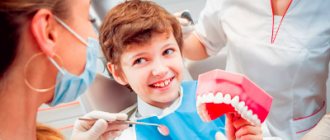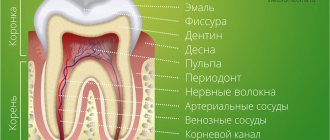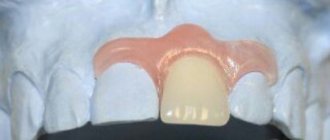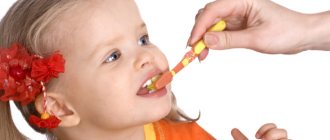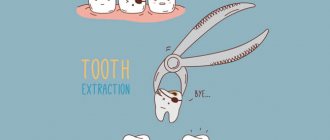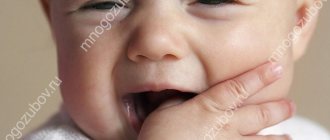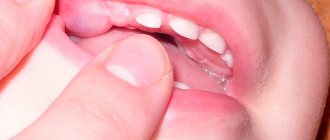Deviations in timing and problems when changing teeth
Every tenth child encounters difficulties in changing teeth. Modern medicine knows many ways to combat the most common abnormalities:
- "Shark's Mouth"
This term refers to the situation when the baby teeth have not yet fallen out, but the molars have already begun to grow in the second row. In this case, you need to immediately go to the dentist as soon as possible so that he can remove unnecessary units.
- Changing teeth too early or too late
If a child's teeth begin to fall out before 5 years or after 8 years, this is considered a deviation. Possible causes include tooth decay, heredity, hormonal problems, jaw injuries and serious illnesses (leukemia, diabetes, etc.).
- Lack of new, permanent teeth
If a tooth has fallen out a long time ago, and a new one does not appear, this is a reason to visit a doctor. The dentist will take an x-ray and see if there is a tooth germ. In its absence, a diagnosis of adentia is made. The problem is quite rare and requires contacting a prosthetist.
Baby teeth in children: loss pattern
Many mothers are concerned about the question of when their children’s baby teeth begin to fall out. As a rule, this process starts immediately before primary school, that is, at the age of 6-7 years. In this case, the pattern of loss of baby teeth in children is similar to the sequence of their eruption. Only the fangs differ, which are replaced later, by the age of 13.
The order in which baby teeth fall out is the same for almost all children. First, molars grow - molars, which were absent in the “milk” set. As soon as there is enough space in the child’s jaw, “sixes” begin to appear. Only after this comes the time to change temporary teeth.
First, the lower incisors fall out, and then the upper ones. After this, the premolars appear at about 9-11 years of age. The last in line are the fangs, which usually fall out by the age of 10-12 years. At the same time, there should already be molars in the child’s mouth. After 18 years, third molars or, as we used to call them, wisdom teeth begin to emerge. However, they do not appear in everyone, which, by the way, does not indicate the presence of any pathologies.
Is it possible to pull out a baby tooth yourself?
You can pull out a tooth yourself only if it barely stays in the socket. Examine the child's jaw for swelling and bleeding. If you have such signs, it is better to visit a dentist. Also, you should not pull out a baby tooth yourself if your child has a cold.
Self-removal occurs as follows. Take a clean cloth and soak it in an alcohol solution. Grab the tooth with it and gently pull it out of the socket until it comes out completely. Rinse your child's mouth. Place clean, treated cotton wool in the hole for 15–20 minutes. Let the child press it well with his teeth. Do not consume food or drinks for 2 hours.
How many baby teeth do children lose?
The very first teeth appear between the ages of six months and one year. First, the incisors appear, located below and in the center, then the upper ones, and only then the lower lateral and upper lateral ones. This is followed by the first molars, canines and second molars. In pediatric practice, such a concept as a dental formula is used, that is, a standard dental set for children: 2 incisors, 2 molars and a canine. Multiplying the data obtained by four, we get 20 – the number of baby teeth is normal. Accordingly, the same number of baby teeth fall out.
Dental clinic "32 Dent" offers a full range of services in the field of pediatric dentistry. To receive complete and detailed answers to all your questions, call the numbers listed on the website.
Why do empty spaces remain unoccupied for a long time?
If new teeth do not appear for a long time, this is due to one of three reasons:
- Edentia. This is the absence of a molar tooth germ. The disease is diagnosed using x-rays. Adentia is rare in children and is easily eliminated with prosthetics.
- Retention. This is a disease in which part of the tooth is either not visible from the gum tissue at all, or is only slightly visible. You need to contact a dentist who will make the correct diagnosis and, possibly, resort to surgery.
- Impact. If the crowns of the teeth are too close together to leave no room for new tooth growth, this is an indication of impaction. It is diagnosed using x-rays.
Complications during teething
- Delay in the appearance of permanent teeth.
This may be due to genetic characteristics, immune system problems and a number of other diseases. - Uneven teeth and other malocclusions.
- Hyperdentia.
The child’s molar tooth (or teeth) grows in the second row. Hyperdentia, or supernumerary of teeth, is a fairly rare phenomenon, but requires the intervention of a dentist to eliminate the risk of malocclusion in a child.
Useful tips for parents
- Monitor your baby's teeth closely. If there are several children in a family, it is better for each of them to have a sign indicating the lost and emerging teeth.
- Teach your child to take care of their teeth. Teach him to brush his teeth twice a day and rinse his mouth after eating. You can use plain water or herbal decoction of chamomile.
- During the teething period, give your child plenty of calcium. Avoid solid foods and feed your baby soft purees, grated fruits and other foods.
- Discuss the upcoming change of teeth with your child so that it does not come as a surprise to him.
If you observe difficulties with the germination of dental units, this is a reason to immediately consult a dentist. Remember that changing teeth is a stressful process for your child. Support him so that this period passes with minimal psychological losses.
What should parents do?
The process of changing teeth in children worries parents, but this is quite natural, and most children do not experience significant pain. However, this does not relieve parents of the need to constantly monitor the condition of their child’s oral cavity. There is no need to remove baby teeth yourself. When the time comes to say goodbye to a tooth, a certain mechanism is activated in the child’s body that dissolves the milk tooth roots. You should seek help from a specialist only if the baby tooth does not want to fall out, but the permanent one is already beginning to appear.
After a tooth falls out, you may experience some bleeding. If desired, have your child rinse his mouth with a solution of soda with a drop of iodine as a preventative measure.
If you have a problem similar to that described in this article, be sure to contact our specialists. Don't diagnose yourself!
Why you should call us now:
- We will answer all your questions in 3 minutes
- Free consultation
- The average work experience of doctors is 12 years
- Convenient location of clinics
Single contact phone number: +7
Make an appointment
What you should pay attention to
The child’s body prepares in advance for the period of teeth change. Here are the main signs of the changes taking place:
- mobility and loosening of primary teeth
- redness and swelling of the gums
- the appearance of interdental spaces due to jaw growth
- the rudiments of a permanent tooth become visible
When a baby tooth is replaced with a permanent one, the root gradually dissolves. The process is helped by a new tooth pushing out the temporary one from below.
Usually children and their parents remove the loose tooth themselves. But we recommend contacting a specialist who will provide professional assistance.
How to determine that a child will soon have molars?
An increase in jaw size is the main sign of a future change of teeth. Visually this may not be noticeable. But the appearance of three and diastema (gaps) between the baby teeth indicates that the child’s jaw is growing and preparing for the formation of a permanent bite.
The following signs are purely individual - they may or may not be present in the child.
- Increased salivation.
- Redness, swelling of the gums and oral mucosa.
- Sore gums.
- Unpleasant itching of the gums.
- Increased body temperature.
- Unreasonable cough, runny nose.
- Stool disorder.
- General malaise, lethargy.
- Loss of appetite.
- Sleep disturbance or, on the contrary, drowsiness.
- Anxiety, irritation, whims.
Important! During the period of permanent teeth erupting, parents should monitor the condition of the child, the oral cavity and gums. If symptoms that cause concern appear, you should immediately consult a doctor - a pediatrician or pediatric dentist.
Impaired eruption of permanent teeth
Parents should start to worry if there are no signs of eruption of a permanent tooth after the loss of a primary tooth for 5 or more weeks. There are several reasons why permanent teeth are “late” to appear:
- Adverse effects on the fetus and newborn baby. What matters are the damaging factors that affected the developing organism during pregnancy and in the first year of life. Illnesses of the mother and child, past infections, taking certain medications, and the consequences of birth trauma can prolong the eruption of permanent teeth.
- Absence or damage of a permanent tooth germ. The formation of teeth occurs in the 2nd trimester of pregnancy. As a rule, under the influence of unfavorable factors, the formation of an entire group or groups of teeth is disrupted. In this case, after the baby teeth fall out, there is no need to wait for permanent teeth to appear. Damage to the tooth germ is in most cases the result of careless dental treatment.
- Incorrect position of the tooth germ in the jaw bone. If the rudiment is located too deep in the tissues, oriented horizontally and not vertically, then tooth eruption will be difficult, if not impossible.
There are no external symptoms by which one could judge the cause of the disorder. You can only conduct an examination, based on the data of which a treatment plan is drawn up. For this, the child must be shown to the dentist. Perhaps, already at this stage, he will offer a consultation with a pediatric orthodontist, who, in turn, will prescribe treatment - orthodontic plates or a more modern and convenient method - aligners.
Process Features
The chewing apparatus in children, in the first years, actively develops and improves. It is explained by the following factors - in the first months of life, it is adapted only to receive breast milk, and then other liquid and porridge-like foods. The eruption of the first milk teeth usually begins at 5-6 months. Around this time, solid foods are gradually introduced into the child's diet.
Parents should know how many baby teeth fall out in children, at what age and what causes this. This process is associated with freeing up space for permanent teeth as the dentofacial apparatus forms. In newborns, the jaw size is quite small, so only 20 milk teeth are placed here - 10 on top and 10 on the bottom. When the size of the jaw bones increases, they are naturally replaced by permanent ones, the number of which is greater (32) and they are larger.
How does teeth change?
The rudiments of future permanent units are located under the root of the baby tooth and are separated from it by a thin bone septum. At 6–7 years of age, osteoclasts of the connective tissue surrounding the baby tooth dissolve the mineral component of the septum and destroy it. At the same time, the pulp of the temporary unit is gradually transformed into granulation connective tissue rich in osteoclasts, which gradually destroy the dentin of the primary tooth. At the same time, the roots of the temporary units dissolve and, in fact, only the crown of the baby tooth remains. It can be easily removed on its own, with the help of the dentist’s manipulations, or it can be pushed out by an actively growing molar (permanent) tooth.
Anatomy of permanent teeth The permanent units of a child (and an adult) have a complex anatomy.
Visually, the tooth consists of three parts - crown, neck, roots.
- The crown is the visible part of the tooth that rises above the gum.
- The neck is the part of the tooth at the gum level, in the place where the crown meets the root, and the enamel of the unit turns into cement.
- The root is the part of the unit invisible to the eye, located in the alveolar socket. The base of each unit is made of dentin, a hard tissue. In the coronal part, dentin is covered with enamel, and in the root part there is cement. Inside the dentin is the dental pulp - loose fibrous soft connective tissue, penetrated by a large number of blood and lymphatic vessels and nerve endings. Passing along the root canal, through the apical foramen located on the upper part of the root, they communicate with the main neurovascular bundle, providing nutrition to the tooth, drainage of excess fluid and its innervation.
Normally, by the age of 13, when a permanent bite is formed, a child has 28 permanent teeth. At the age of 17 - 25 years, third molars (wisdom teeth) erupt and the number of units may increase - 32 teeth.
At what age do radical units appear?
We can talk about adult occlusion only a few years after the start of the change in time units. Typically, a stronger replacement will erupt several weeks or months (or, if pulled out prematurely, years) after the baby teeth fall out.
Central incisors grow from 6 to 8 years of age, lateral incisors from 7 to 9, premolars and canines from 9 to 12. Molars begin to grow at approximately six years of age. They immediately grow permanently, replacing the empty space.
Complete replacement of baby teeth with permanent teeth. Deadlines, features.
Features of replacing baby teeth with permanent ones
Often, during the process of replacing teeth, certain features and unusual situations are observed that become a cause for concern for parents.
Let’s briefly look at the most common parental questions: 1. What reactions can a child’s body have when baby teeth fall out and during the period of growth of permanent teeth?
Answer: The process of replacing teeth is virtually painless. Baby teeth fall out on their own after complete resorption of the root or are removed at home, or better yet, by a pediatric dentist, when the permanent tooth is already growing and the baby tooth has not yet fallen out. The eruption of permanent teeth is not accompanied by pain. In very rare cases, there may be a slight increase in temperature, abdominal pain, and itching of the gums. No treatment is required, but consultation with a dentist is recommended.
2. Why do paired teeth not fall out at the same time, but sometimes with a long period of time?
Answer: Firstly, this is what nature intended, and for each child individually. Secondly, it all depends on the time period of resorption of the root of a baby tooth. If baby teeth have been treated or filled, then the root resolves much more slowly, sometimes it does not resolve at all. Filled roots of baby teeth often have to be removed by a dentist because they may not fall out on their own.
3. Why does a lot of time often pass between the loss of a baby tooth and the appearance of a permanent one?
Answer: As a rule, the front teeth grow quickly. But premolars ( baby molars ) and canines are often delayed. After a temporary tooth falls out, it may even take 4-6 months until a permanent tooth erupts in that place. Therefore, you just have to wait and get quality care. But if the period exceeds six months, and you are very worried, come to the appointment. After the examination, the doctor will decide whether it is necessary to stimulate the growth of a permanent tooth.
4. Which teeth should 8-year-old children change?
Answer: By the age of eight, a child should normally have the following permanent teeth - 6th molars, 4 upper incisors and 4 lower incisors. Plus/minus six months is the norm.
5. Why is it necessary to treat caries in children if you then have to pull out the filled roots of baby teeth?
Answer: We have already written (“What is the danger of premature removal of baby teeth”) that an empty space in the dentition contributes to the shifting of existing baby teeth, which means that the rudiments of permanent teeth underneath them shift and they grow incorrectly - in one place they overlap each other each other, and in the other, cracks form. A treated, filled baby tooth preserves space for a permanent tooth. An untreated tooth infects the germ of the permanent tooth with caries, which can lead to deformation or even the absence of the latter.
6. Why does a child aged 7-14 years sometimes experience toothache , but the teeth are all intact?
Answer: Yes, this phenomenon occurs, but it is not the tooth itself that hurts, but the jaw, which is rapidly growing at this age. Permanent teeth are almost twice the size of baby teeth, which means they need much more space. If the new teeth are large, then they can even overlap each other, get out of the dentition, or grow at an angle to each other. As the jaw grows, they settle into place and align. But only a qualified specialist can correctly assess such a situation and the danger of developing defects and anomalies, so consult an orthodontist at the Utkinzub clinic.
7. At what age should a bite be corrected?
Answer: The best option is before the change of baby teeth, from 4-5 years. In this case, permanent teeth will grow, as a rule, evenly, in the place intended by nature. There will be no need for subsequent long-term bite correction. In any case, if there is a malocclusion, the sooner you contact a qualified orthodontist, the faster and better the problem will be eliminated. Read more in the article “Treatment of malocclusions.”
To the question: how to treat caries of baby teeth , you will find a complete answer in the section on caries of children's teeth. It also provides recommendations for the prevention of caries, as well as rotten teeth in children photo . Read about other dental changes in children, diseases, methods of treating them, eliminating deficiencies and pathologies in special articles. Enter the information you are interested in in the “Search on the site” section and you will find articles with answers from our qualified specialists. Or make an appointment with a pediatric dentist at the Utkinzub clinic , especially during the period of eruption of the first teeth and the replacement of temporary teeth with permanent ones in your children.
Classification and purpose of teeth
As a person grows older, the dental apparatus first includes temporary, then permanent units. When the first ones fall out, the root chewing organs grow in the same place. Depending on where they are located, their function and shape are different.
- The incisors are located in the middle of the row. They have a single root as well as a cutting edge. Their shape is flat. The frontal organs are involved in biting food. They do not perform chewing functions; they cannot bear heavy loads. If the crowns are crooked, orthodontics deals with the correction of the dental anomaly. When the frontal unit is lost, not only does a cosmetic defect appear, it makes it difficult for a person to bite off food.
- The canines grow behind the incisors. Their task is to tear off rough and tough parts of food. They, like the incisors, are single-rooted. The root of such units is powerful. This makes it possible to cope with significant loads.
- The small molars, or premolars, are located immediately behind the canines. They have a large crown. With its help, a person not only grabs food, but also tears it off and chews food. Many premolars have one root.
- Wisdom teeth grow behind the small molars. The third molar can appear not only at 20 years old, but even at 30 and 40. It happens that wise units are missing. Molars crush and grind food. The upper organs usually have 3 roots, the lower ones - two. It happens that the number of roots reaches four or five.
In appearance, the permanent units are much more bumpy than the milk units. The roots of the indigenous organs are narrow. The anatomical structure is also different. Temporary crowns have thinner walls. The lateral surface of enamel and dentin does not exceed one millimeter in thickness.
